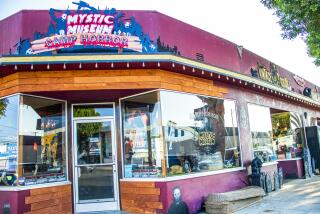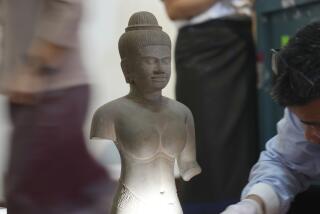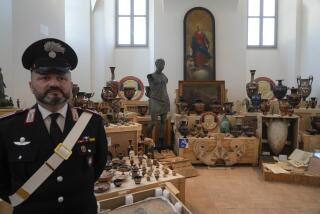Missing Artifacts Secured, U.S. Says
BAGHDAD — U.S. occupation authorities announced the recovery Saturday of most of the items feared looted from the National Museum here, after museum officials revealed where the artifacts had been taken for safekeeping.
Also Saturday, attackers using rocket-propelled grenades and small arms killed a U.S. soldier near Tikrit and wounded four more. And a new mass grave was found, reported to contain the remains of prisoners that Saddam Hussein’s regime executed in its last days.
U.S. troops were widely criticized for failing to secure the National Museum when they entered the city in early April. Last month, occupation authorities said it appeared that most of the antiquities had been locked in a secret vault for safekeeping, and museum staff disclosed the location of that hideaway this week, an occupation official told reporters.
Of the 170,000 items in the museum collection, only 3,000 objects remain unaccounted for, the official said. In addition, a famed collection of ancient gold and enamel jewelry known as the Treasure of Nimrud has been found in good condition in the flooded vault of the Iraqi Central Bank, the official said.
The vault was flooded during the looting spree that gripped Baghdad in the first days after U.S. troops entered the city. The Nimrud trove is from the ancient kingdom of Assyria and is dated around 900 BC.
The incident near Tikrit was the second fatal attack on U.S. forces in three days. In Fallouja on Thursday, one soldier was killed and five were injured. The 150,000 troops attempting to control Iraq face a confused jumble of friendship, hostility and danger.
Despite the 100-degree-plus heat, GIs are out in the glaring sun in long-sleeved, helmeted, flak-jacketed combat gear, sweat running down their faces, rifles and machine guns always at the ready.
They ride in their Humvees and Bradley fighting vehicles along almost every main street and many smaller, dust-clogged lanes and set up checkpoints to search for weapons.
In most places, they get friendly waves from the children and banter with adults who can speak English. But wariness and hostility are often close to the surface, especially lately in the insular, mainly Sunni cities of Fallouja, Tikrit and Hit that are situated north and west of Baghdad.
A statement from the U.S. Central Command provided few details of Saturday’s attack outside Tikrit, the home city of Hussein that is considered a lair for remaining Baath Party loyalists. The identities of the slain soldier and the four who were injured were withheld until relatives were notified.
In Fallouja, where American forces have been met by cold stares and suffered occasional bloodshed since they arrived in mid-April, the soldiers Saturday morning surrounded an Agriculture Ministry storage facility that had been looted of trucks and irrigation gear overnight, then set ablaze.
Soldiers took two Iraqis into custody while a crowd of about 100 young men stared sullenly.
Many in the crowd blamed the looting on the Americans, saying they had not secured the facility.
But a guard admitted that the U.S. troops were not summoned for eight or nine hours because the local people thought they could deal with the thieves themselves. Once told, the Americans showed up in half an hour, he said.
Meanwhile, the latest mass grave of the regime’s victims was discovered near Salman Pak, about 15 miles south of Baghdad.
Residents, quoted by news agencies, said that five corpses had been removed but that the site at a military complex could contain 100 bodies. The victims were described as young men killed as recently as April 4, when U.S. troops were on the verge of entering the town.
*
Times staff writer Azadeh Moaveni in Baghdad and Times wire services contributed to this report.
More to Read
Sign up for Essential California
The most important California stories and recommendations in your inbox every morning.
You may occasionally receive promotional content from the Los Angeles Times.










